Antioxidant and Anti-Breast Cancer Properties of Hyaluronidase from Marine Staphylococcus aureus (CASMTK1)
Abstract
:1. Introduction
2. Materials and Methods
2.1. Sample Collection and Isolation of Staphylococcus Species
2.2. Morphological and Molecular Identification of Staphylococcus Species
2.3. Sequencing and Phylogenetic Analysis of 16S rDNA Gene
2.4. Enzyme Assay
2.5. Optimization of Staphylococcal Hyaluronidase
2.5.1. Effect of Salinity
2.5.2. Effect of pH
2.5.3. Effect of Temperature
2.5.4. Effect of Incubation Period
2.5.5. Effect of Carbon Sources
2.5.6. Effect of Inorganic Nitrogen Sources
2.6. Purification of Staphylococcal Hyaluronidase
2.7. FT-IR and FT-R Spectro Photometry Data Analysis
2.8. Antioxidant Properties of Staphylococcal Hyaluronidase
2.9. Measurement of Cell Proliferation by MTT Cytotoxicity Assay
2.10. Measurement of Intracellular Reactive Oxygen Species (ROS) in MCF-7 Cells
2.11. Apoptotic Changes by Acridine Orange/Ethidium Bromide Dual Staining Method
2.12. Statistical Analysis
3. Results
3.1. Morphological and Molecular Identification of Staphylococcus sp. CASMTK1
3.2. Enzyme Assay and Molecular Weight Analysis Using SDS- PAGE
3.3. Optimization of Staphylococcal Hyaluronidase Production from Marine S. aureus
3.4. FT-IR and FT-R Spectroscopy Studies of Staphylococcal Hyaluronidase
3.5. In-Vitro Antioxidant Properties
3.6. Effect of Staphylococcal Hyaluronidase on Cell Proliferation in MCF-7 Breast Cancer Cells (MTT Assay)
3.7. Effect of Staphylococcal Hyaluronidase on Intracellular ROS Levels in MCF-7 Cells
3.8. Effect of Staphylococcal Hyaluronidase on Apoptotic Changes in MCF-7 Cells
4. Discussion
5. Conclusions
Supplementary Materials
Author Contributions
Funding
Institutional Review Board Statement
Informed Consent Statement
Data Availability Statement
Acknowledgments
Conflicts of Interest
References
- World Health Organisation (WHO). International Statistical Classification of Tumors of the Breast. 2023. Available online: https://www.iarc.who.int (accessed on 26 December 2022).
- Siegel, R.L.; Miller, K.D.; Fuchs, H.E.; Jemal, A. Cancer statistics, 2022. CA Cancer J. Clin. 2022, 7, 7–33. [Google Scholar] [CrossRef] [PubMed]
- Renan, M.J. How many mutations are required for tumorigenesis? Implications from human cancer data. Mol. Carcinog. 1993, 7, 139–146. [Google Scholar] [CrossRef] [PubMed]
- Al-Shamsi, H.O.; Abu-Gheida, I.H.; Iqbal, F.; Al-Awadhi, A. Cancer in the Arab World; Springer: Berlin/Heidelberg, Germany, 2022; p. 476. [Google Scholar] [CrossRef]
- Torre, L.A.; Islami, F.; Siegel, R.L.; Ward, E.M.; Jemal, A. Global cancer in women: Burden and trends. Cancer Epidemiol. Biomark. Prev. 2017, 26, 444–457. [Google Scholar] [CrossRef] [PubMed] [Green Version]
- Harbeck, N.; Penault-Llorca, F.; Cortes, J.; Gnant, M.; Houssami, N.; Poortmans, P.; Ruddy, K.; Tsang, J.; Cardoso, F. Brest Cancer. Nat. Rev. 2019, 5, 66. [Google Scholar] [CrossRef]
- Waks, A.G.; Winer, E.P. Breast cancer treatment: A review. J. Am. Med. Assoc. 2019, 321, 288–300. [Google Scholar] [CrossRef]
- Bedard, P.L.; Hyman, D.M.; Davids, M.S.; Siu, L.L. Small molecules, big impact: 20 years of targeted therapy in oncology. Lancet 2020, 395, 1078–1088. [Google Scholar] [CrossRef]
- Bedard, P.L.; Piccat-Gebhart, M.J. Current paradigms for the use of HER2-Targeted therapy in early-stage breast cancer. Clin. Breast Cancer 2008, 8, 157–165. [Google Scholar] [CrossRef]
- Bouris, P.; Skandalis, S.S.; Piperigkou, Z.; Afratis, N.; Karamanou, K.; Altras, A.J.; Moustakas, A.; Theocharis, A.D.; Karamanos, N.K. Estrogen receptor alpha mediates epithelial to mesenchymal transisition, expression of specific matrix effectors and functional properties of breast cancer cells. Matrix Biol. 2015, 43, 42–60. [Google Scholar] [CrossRef]
- Piperigou, Z.; Bouris, P.; Onisto, M.; Franchi, M.; Kletsas, D.; Theocharis, A.D.; Karamanos, N.K. Estrogen receptor beta modulates breast cancer cells functional properties, signaling and expression of matrix molecules. Matrix Biol. 2016, 56, 4–23. [Google Scholar] [CrossRef]
- Wilkes, G.M. Targeted therapy: Attacking cancer with molecular and immunological targeted agents. Asia Pac. J. Oncol. Nurs. 2018, 5, 137–155. [Google Scholar] [CrossRef]
- Meiser, B.; Wong, W.K.T.; Peate, M.; Julian-Reynier, C.; Kirk, J.; Mitchell, G. Motivators and barriers of tamoxifen use as risk reducing medication amongst women at increased breast cancer risk: A systematic literature review. Hered. Cancer Clin. Pract. 2017, 15, 14. [Google Scholar] [CrossRef] [Green Version]
- Cuzick, J.; Sestak, I.; Bonanni, B.; Costantino, J.P.; Cummings, S.; DeCensi, A.; Dowsett, M.; Forbes, J.F.; Ford, L.; LaCroix, A.Z.; et al. Selective oestrogen receptor modulators in prevention of breast cancer: An updated meta-analysis of individual participant data. Lancet 2013, 25, 1827–1834. [Google Scholar] [CrossRef] [Green Version]
- Nazarali, S.A.; Narod, S.A. Tamoxifen for women at high risk of breast cancer. Breast Cancer 2014, 6, 29–36. [Google Scholar] [CrossRef] [Green Version]
- Fabian, C.J. The What, Why and how of aromatase inhibitors: Hormonal agents for treatment and prevention of breast cancer. Int. J. Clin. Pract. 2007, 61, 2051–2063. [Google Scholar] [CrossRef] [Green Version]
- Krens, S.D.; McLeod, H.L.; Hertz, L.D. Pharmacogenetics, enzyme probes and therapeutic drug monitoring as potential tools for individualizing taxane therapy. Pharmacogenomics 2013, 14, 555–574. [Google Scholar] [CrossRef] [Green Version]
- Oun, R.; Moussa, Y.E.; Wheate, N.J. The side effects of platinum-based chemotherapy drugs: A review for chemists. Dalt. Trans. 2018, 47, 6645–6653. [Google Scholar] [CrossRef]
- Anitha, P.; Bhargavi, J.; Sravani, B.; Aruna, B.; Ramkanth, S. Recent progress of dendrimers in drug delivery for cancer therapy. Int. J. Appl. Pharm. 2018, 10, 34–42. [Google Scholar] [CrossRef] [Green Version]
- Afonso, V.; Champy, R.; Mitrovic, D.; Collin, P.; Lomri, A. Reactive oxygen species and superoxide dismutases: Role in joint diseases. Jt. Bone Spine 2007, 74, 324–329. [Google Scholar] [CrossRef]
- Valko, M.; Leibfritz, D.; Moncol, J.; Cronin, M.T.; Maur, M.; Telser, J. Free radicals and antioxidants in normal physiological functions and human disease. Int. J. Biochem. Cell Biol. 2007, 39, 44–84. [Google Scholar] [CrossRef]
- Ravikumar, S.; Kathiresan, K. Marine Pharmacology; School of Marine Sciences, Alagappa University: Karaikudi, India, 2010; p. 215. [Google Scholar]
- Jung, H. Hyaluronidase: An overview of its properties, applications, and side effects. Arch. Plast. Surg. 2020, 47, 297–300. [Google Scholar] [CrossRef]
- Hynes, W.L.; Walton, S. Hyaluronidase of Gram-Positive Bacteria. FEMS Microbiol. Lett. 2000, 183, 201–207. [Google Scholar] [CrossRef] [PubMed]
- Weber, G.C.; Buhren, B.A.; Schrumpf, H.; Wohlrab, J.; Gerber, P.A. Clinical applications of hyaluronidase. Adv. Exp. Med. Biol. 2019, 1148, 255–277. [Google Scholar] [CrossRef]
- Cavallini, M.; Gazzola, R.; Metalla, M. The role of hyaluronidase in the treatment of complications from hyaluronic acid dermal fillers. Aesthetic Surg. J. 2013, 33, 1167–1174. [Google Scholar] [CrossRef] [PubMed] [Green Version]
- Kloos, W.E.; Schleifer, K.H. Genus IV. Staphylococcus. In Bergey’s Manual of Systematic Bacteriology; Sneath, P.H.A., Mair, N.S., Sharpe, M.E., Holt, J.G., Eds.; Williams & Wilkins: Baltimore, MD, USA, 1986; Volume 2, pp. 1013–1035. [Google Scholar]
- Zhang, K.; Jo-Ann, M.; Sameer, E.; Thomas, L.; John, M.C. Novel Multiplex PCR Assay for Characterization and Concomitant Subtyping of Staphylococcal Cassette Chromosome mec Types I to V in Methicillin-Resistant Staphylococcus aureus. J. Clin. Microbiol. 2005, 43, 5026–5033. [Google Scholar] [CrossRef] [PubMed] [Green Version]
- Tamura, K.; Stecher, G.; Peterson, D.; Filipski, A.; Kumar, S. MEGA6: Molecular Evolutionary Genetics Analysis version 6.0. Mol. Biol. Evol. 2013, 30, 2725–2729. [Google Scholar] [CrossRef] [Green Version]
- Tam, Y.C.; Chan, E.C.S. Modifications enhancing reproducibility and sensitivity in the turbidimetric assay of hyaluronidase. J. Microbiol. Methods 1983, 1, 255–266. [Google Scholar] [CrossRef]
- Bradford, M.M. A Rapid and Sensitive Method for the Quantification of Microgram Quantities of Protein Utilizing the Principle of Protein Dye Binding. Anal. Biochem. 1976, 72, 248–254. [Google Scholar] [CrossRef]
- Xie, J.; Rileya, C.; Kumar, M.; Chittura, K. FTIR/ATR study of protein adsorption and brushite transformation to hydroxyapatite. Biomaterials 2002, 23, 3609–3616. [Google Scholar] [CrossRef]
- Oyaizu, M. Studies on Product of Browning Reaction Prepared from Glucose Amine. Jpn. J. Nutr. 1986, 44, 307–315. [Google Scholar] [CrossRef] [Green Version]
- Mensor, L.L.; Menezes, F.S.; Leitao, G.G.; Reis, A.S.; Dos Santos, T.S.; Coube, C.S.; Leitao, S.G. Screening of Brazilian Plant Extracts for Antioxidant Activity by the Use of Dpph Free Radical Method. Phytother. Res. 2001, 15, 127–130. [Google Scholar] [CrossRef]
- Miller, N.J.; Castelluccio, C.; Tijburg, L.; Rice-Evans, C. The Antioxidant Properties of Theaflavins and their Gallate Esters-Radical Scavengers or Metal Chelators. FEBS Lett. 1996, 392, 40–44. [Google Scholar] [CrossRef] [PubMed] [Green Version]
- Nishikimi, M.; Appaji, N.; Yagi, K. The Occurrence of Superoxide Anion in the Reaction of Reduced Phenazine Methosulfate and Molecular Oxygen. Biochem. Biophys. Res. Commun. 1972, 46, 849–854. [Google Scholar] [CrossRef] [PubMed]
- Halliwell, B.; Gutteridge, J.M.; Aruoma, O.I. The Deoxyribose Method: A Simple Test Tube Assay for Determination of Rate Constants for Reactions of Hydroxyl Radicals. Anal. Biochem. 1987, 165, 215–219. [Google Scholar] [CrossRef]
- Mosmann, T. Rapid Colorimetric Assay for Cellular Growth and Survival, Application to Proliferation and Cytotoxicity Assays. J. Immunol. Met. 1983, 65, 55–63. [Google Scholar] [CrossRef] [PubMed]
- Philipson, L.H.; Westley, J.; Schwartz, N. Effect of Hyaluronidase Treatment of Intact Cells on Hyaluronate Synthetase Activity. Biochemistry 1985, 24, 7899–7906. [Google Scholar] [CrossRef]
- Lakshmi, S.; Dhanaya, G.S.; Joy, B.; Padmaja, G.; Remani, P. Inhibitory Effect of an Extract of Curcuma Zedoariae on human Cervical Carcinoma Cells. Med. Chem. Res. 2008, 17, 335–344. [Google Scholar] [CrossRef]
- Gunn, B.A.; Colwell, R.R. Numerical Taxonomy of Staphylococci Isolated from the Marine Environment. Int. J. Syst. Bacteriol. 1983, 33, 751–759. [Google Scholar] [CrossRef]
- Irina, A.B. Incidence and Characteristics of Staphylococcus aureus and Listeria monocytogenes from the Japan and South China seas. Mar. Poll. Bull. 2011, 62, 382–387. [Google Scholar] [CrossRef]
- Silva, V.; Ferreira, E.; Manageiro, V.; Reis, L.; Tejedor-Junco, M.T.; Sampaio, A.; Capel, J.L.; Caniça, M.; Igrejas, G.; Poeta, P. Distribution and Clonal Diversity of Staphylococcus aureus and Other Staphylococci in Surface Waters: Detection of ST425-t742 and ST130-t843 mecC-Positive MRSA Strains. Antibiotics 2021, 10, 1416. [Google Scholar] [CrossRef]
- Gerken, T.J.; Roberts, M.C.; Dykema, P.; Melly, G.; Lucas, D.; De Los Santos, V.; Gonzalez, J.; Butaye, P.; Wiegner, T.N. Environmental Surveillance and Characterization of Antibiotic Resistant Staphylococcus aureus at Coastal Beaches. Antibiotics 2021, 10, 980. [Google Scholar] [CrossRef]
- Chun, J.; Rainey, F.A. Integrating genomics into the taxonomy and systematics of the Bacteria and Archaea. Int. J. Syst. Evol. Microbiol. 2014, 64, 316–324. [Google Scholar] [CrossRef] [Green Version]
- Zhu, C.; Zhang, J.; Li, L.; Zhang, J.; Jiang, Y.; Shen, Z.; Guan, H.; Jiang, X. Purification and characterization of Hyaluronate Lyase from Arthrobacter globiformis A152. Appl. Biochem. Biotechnol. 2017, 182, 216–228. [Google Scholar] [CrossRef]
- Essers, L.; Radebold, K. Rapid and reliable identification of Staphylococcus aureus by a latex agglutination test. J. Clin. Microbiol. 1980, 12, 641–643. [Google Scholar] [CrossRef] [Green Version]
- Adingra, A.; Kouadio, A.N.; Ble, M.C.; Kouassi, A.M. Bacteriological Analysis of Surface Water Collected from the Grand-Lahou Lagoon, Cote Divoire. Afr. J. Microbiol. Res. 2012, 6, 3097–3105. [Google Scholar] [CrossRef]
- Lengeler, J.W.; Jahreis, K. Bacterial PEP-dependent carbohydrate: Phosphotransferase systems couple sensing and global control mechanisms. Contrib. Microbiol. 2009, 16, 65–87. [Google Scholar] [CrossRef]
- Sahoo, S.; Prasana, K.P.; Satya, R.M.; Anindita, N.; Poluri, E.; Sashi, K.D. Optimization of Some Physical and Nutritional Parameters for the Production of Hyaluronidase by Streptococcus equi SED 9. Acta Pol. Pharm. 2007, 64, 517–522. [Google Scholar]
- Wang, L.; Liu, Q.; Hao, R.; Xiong, J.; Li, J.; Guo, Y.; He, L.; Tu, Z. Characterization of a Hyaluronidase-Producing Bacillus sp. CQMU-D Isolated from Soil. Curr. Microbiol. 2022, 79, 328. [Google Scholar] [CrossRef]
- Sting, R.; Schaufuss, P.; Blobel, H. Isolation and characterization of hyaluronidases from Streptococcus dysgalactiae, S. zooepidemicus and S. equi. Zentralbl. Bakteriol. 1990, 272, 276–282. [Google Scholar] [CrossRef]
- Sun, J.; Han, X.; Song, G.; Gong, Q.; Yu, W. Microbacterium Cloning, expression, and characterization of a new glycosamino-glycan lyase from sp. H14. Mar. Drugs 2019, 17, 681. [Google Scholar] [CrossRef] [Green Version]
- Lee, S.Y.; Kang, M.S.; Jeong, W.Y.; Han, D.W.; Kim, K.S. Hyaluronic acid based theranostic nanomedicines for targeted cancer therapy. Cancers 2020, 12, 940. [Google Scholar] [CrossRef] [Green Version]
- Jamal, A.A.; Yahya, M.; Dieter, S.; Siegfried, W.; Reinhard, N. Characterization of Enzymatically Digested Hyaluronic Acid Using NMR, Raman, IR, and UV/Vis spectroscopies. J. Pharm. Biomed. Anal. 2003, 31, 545–550. [Google Scholar] [CrossRef]
- Schwaighofer, A.; Ablasser, S.; Lux, L.; Kopp, J.; Herwig, C.; Spadiut, O.; Lendl, B.; Slouka, C. Production of Active Recombinant Hyaluronidase Inclusion Bodies from Apis mellifera in E. coli Bl21(DE3) and characterization by FT-IR Spectroscopy. Int. J. Mol. Sci. 2020, 21, 3881. [Google Scholar] [CrossRef] [PubMed]
- Campo, G.M.; Avenoso, A.; Campo, S.; D’Ascola, A.; Ferlazzo, A.M.; Calatroni, A. The antioxidant and antifibrogenic effects of the glycosaminoglycans hyaluronic acid and chondroitin-4-sulphate in a subchronic rat model of carbon tetrachloride-induced liver fibrogenesis. Chem. Biol. Interact. 2004, 148, 125–138. [Google Scholar] [CrossRef] [PubMed]
- Chunlin, K.; Lanping, S.; Deliang, Q.; Di, W.; Xiaoxiong, Z. Antioxidant activity of low molecular weight hyaluronic acid. Food Chem. Toxicol. 2011, 49, 2670–2675. [Google Scholar] [CrossRef]
- Krasin’ ski, R.; Tchórzewski, H.; Lewkowicz, P. Antioxidant effect of hyaluronan on polymorphonuclear leukocyte-derived reactive oxygen species is dependent on its molecular weight and concentration and mainly involves the extracellular space. Postep. Hig. Med. Dosw. 2009, 63, 205–212. [Google Scholar]
- Mercê, A.L.R.; Marques Carrera, L.C.; Santos Romanholi, L.K.; Lobo Recio, M.Á. Aqueous and solid complexes of iron (III) with hyaluronic acid: Potentiometric titrations and infrared spectroscopy studies. J. Inorg. Biochem. 2002, 89, 212–218. [Google Scholar] [CrossRef]
- Suffness, M.; Pezzuto, J.M. Assays related to cancer drug discovery. In Methods in Plant Biochemistry: Assays for Bioactivity; Hostettmann, K., Ed.; Academic Press: London, UK, 1990; Volume 6, pp. 71–133. [Google Scholar]
- Kalidasan, K.; Asmathunisha, N.; Gomathi, V.; Dufossé, L.; Kathiresan, K. Isolation and Optimization of Culture Conditions of Thraustochytrium kinnei for Biomass Production, Nanoparticle Synthesis, Antioxidant and Antimicrobial Activities. J. Mar. Sci. Eng. 2021, 9, 678. [Google Scholar] [CrossRef]
- Kalidasan, K.; Dufossé, L.; Manivel, G.; Senthilraja, P.; Kathiresan, K. Antioxidant and Anti-Colorectal Cancer Properties in Methanolic Extract of Mangrove-Derived Schizochytrium sp. J. Mar. Sci. Eng. 2022, 10, 431. [Google Scholar] [CrossRef]
- Kalidasan, K.; Ravi, V.; Sunil, K.S.; Maheshwaran, M.L.; Kathiresan, K. Antimicrobial and anticoagulant activities of the spine of stingray Himantura imbricate. J. Coast. Life Med. 2014, 2, 89–93. [Google Scholar]
- Roy, S.; Khanna, S.; Nallu, K.; Hunt, T.K.; Sen, C.K. Dermal wound healing is subject to redox control. Mol. Ther. 2006, 13, 211–220. [Google Scholar] [CrossRef]
- Rathore, R.; Zheng, Y.M.; Niu, C.F.; Liu, Q.H.; Korde, A.; Ho, Y.S.; Wang, Y.X. Hypoxia activates NADPH oxidase ot increase (ROS)I and (Ca2+)I through the mitochondrial ros-pkcepsilon signaling axis in pulmonary artery smooth muscle cells. Free Radic. Biol. Med. 2008, 45, 1223–1231. [Google Scholar] [CrossRef] [Green Version]
- Larnier, C.; Kerneur, C.; Robert, L.; Moczar, M. Effect of Testicular Hyaluronidase on Hyaluronate Synthesis by Human Skin Fibroblasts in Culture. Biochim. Biophys. Acta 1989, 1014, 145–152. [Google Scholar] [CrossRef]
- Spruss, T.; Bernhardt, G.; Schonenberger, H.; Schiess, W. Hyaluronidase Significantly Enhances the Efficacy of Regional Vinblastine Chemotherapy of Malignant Melanoma. J. Cancer Res. Clin. Oncol. 1995, 121, 193–202. [Google Scholar] [CrossRef]
- Baumgartner, G.; Gomar-Hoss, C.; Sakr, L.; Ulsperger, E.; Wogritsch, C. The Impact of Extracellular Matrix on the Chemoresistance of Solid Tumors Experimental Clinical Results of Hyaluronidase as Additive to Cytostatic Chemotherapy. Cancer Lett. 1998, 131, 85–99. [Google Scholar] [CrossRef]
- Fallacara, A.; Baldini, E.; Manfredini, S.; Vertuani, S. Hyaluronic acid in the third Millennium. Polymers 2018, 10, 701. [Google Scholar] [CrossRef] [Green Version]
- Brekken, C.; Bruland, O.S.; De Lange Davies, C. Interstitial fluid Pressure in Human Osteosarcoma Xenografts, significance of Implantation site and the Response to Intratum-oral Injection of Hyaluronidase. Anticancer Res. 2000, 20, 3503–3512. [Google Scholar]
- Surh, Y.J. Cancer Chemoprevention with Dietary Phytochemicals. Nat. Rev. 2003, 3, 768–780. [Google Scholar] [CrossRef]


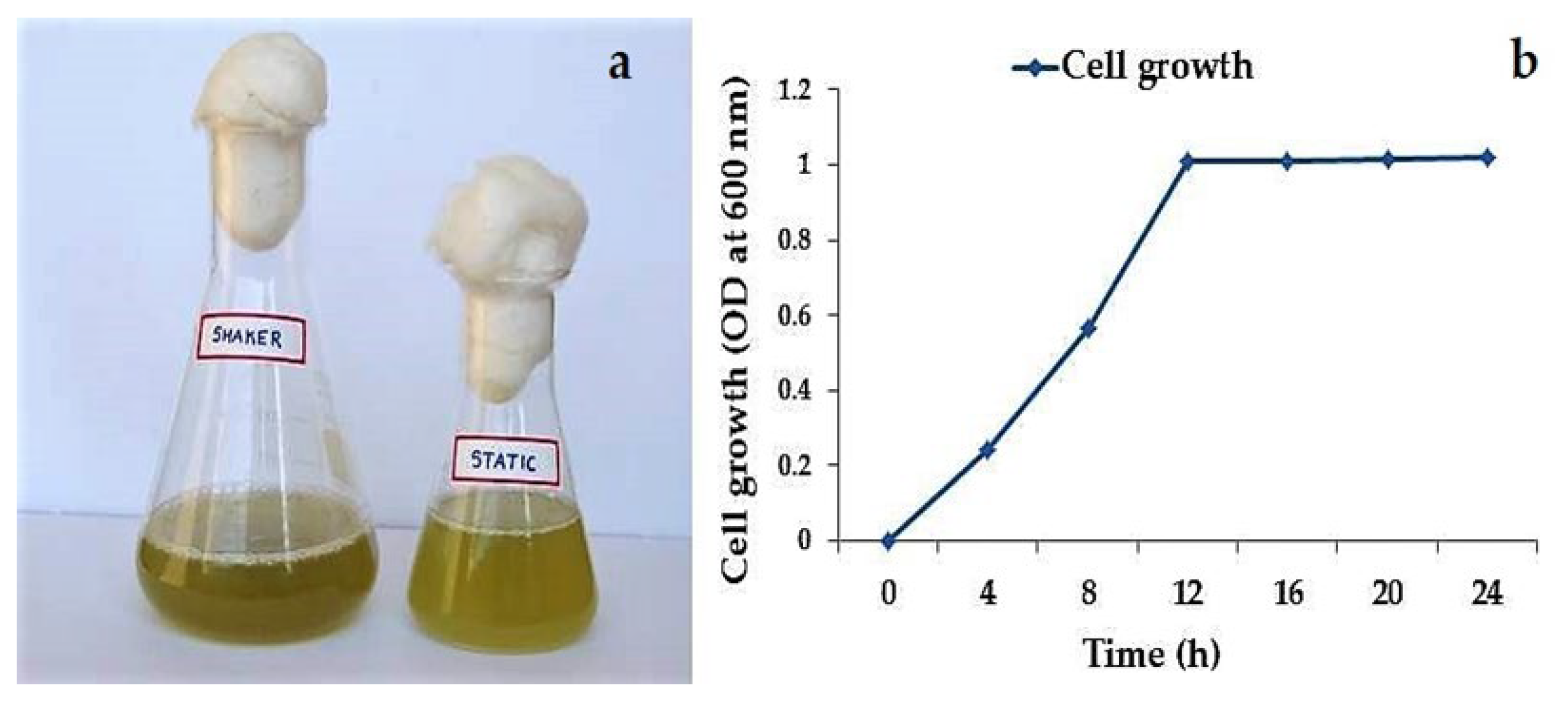
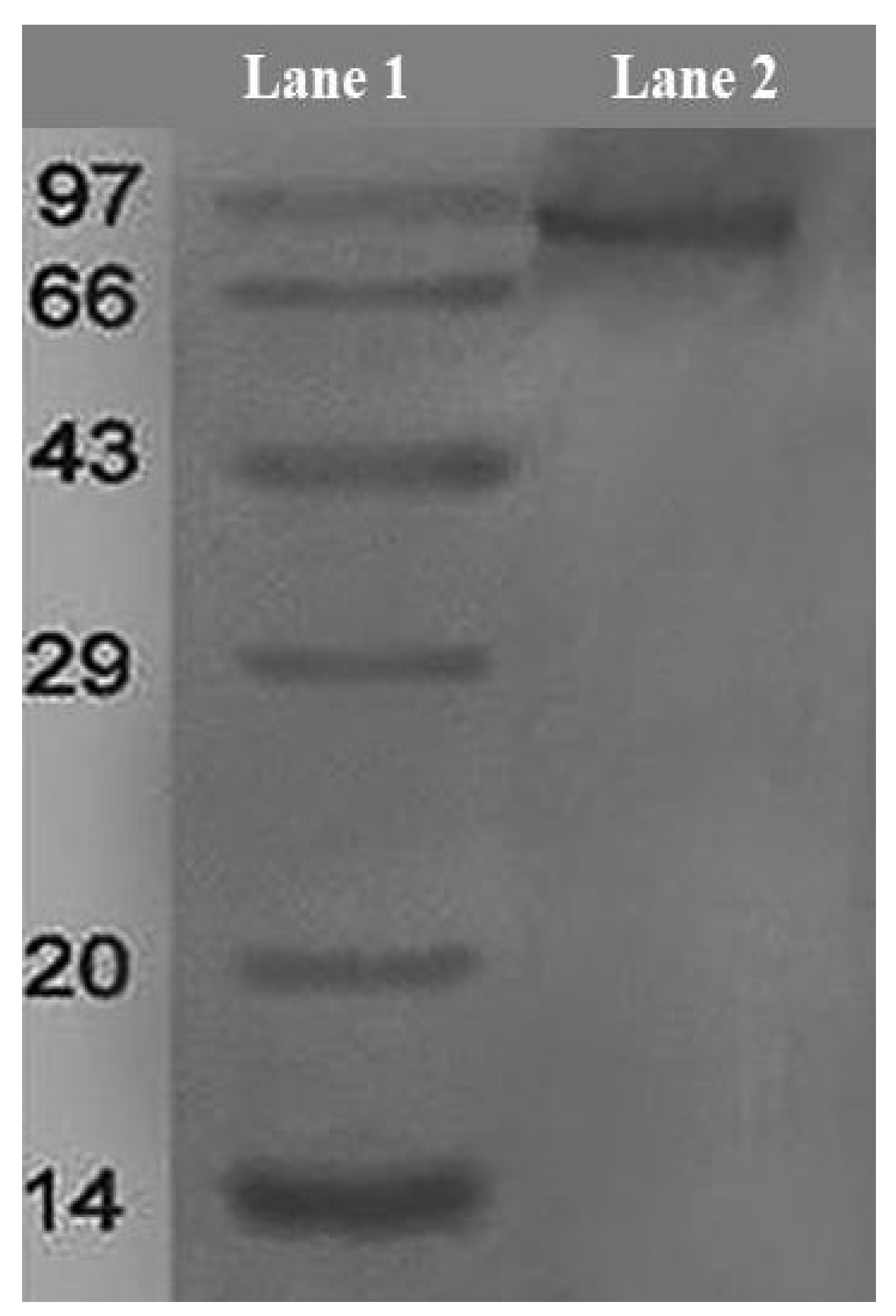
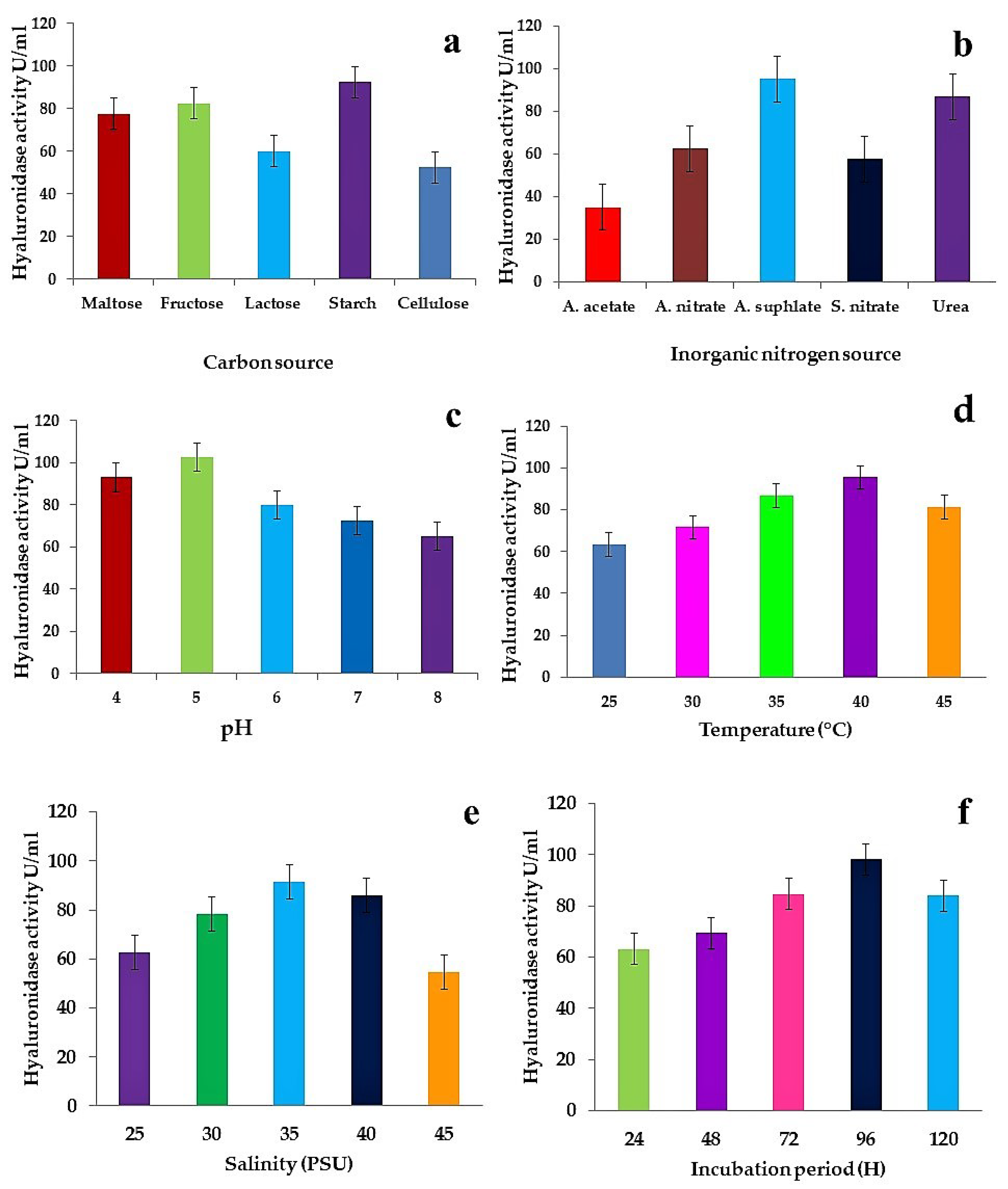

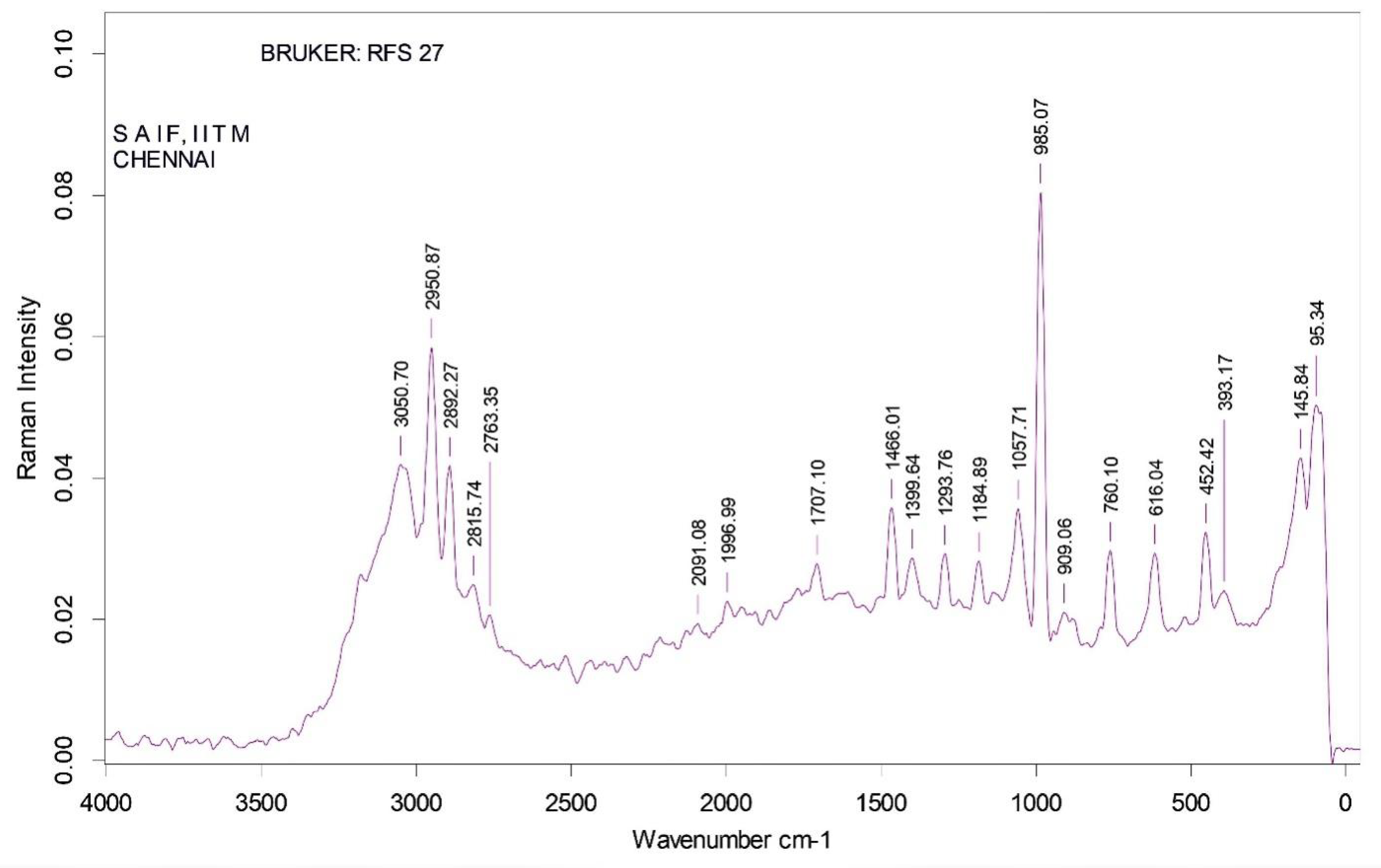

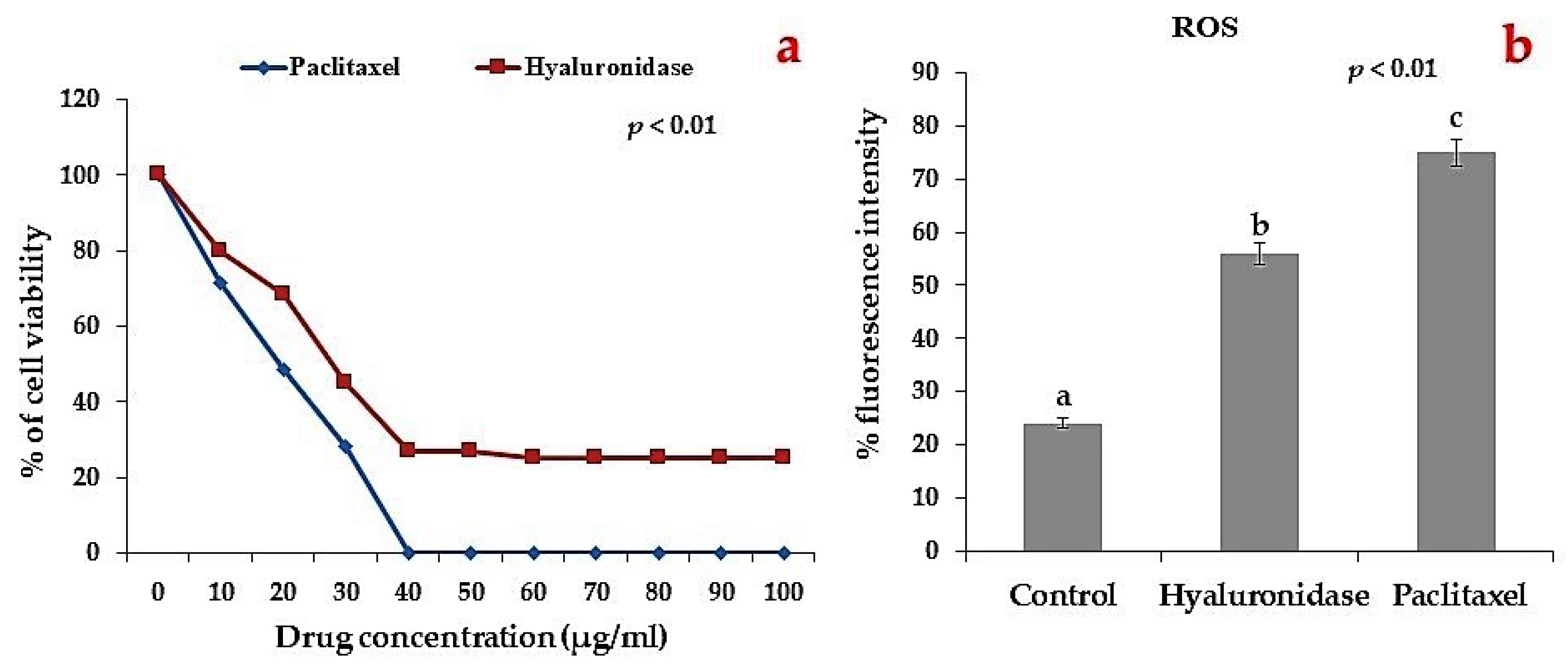

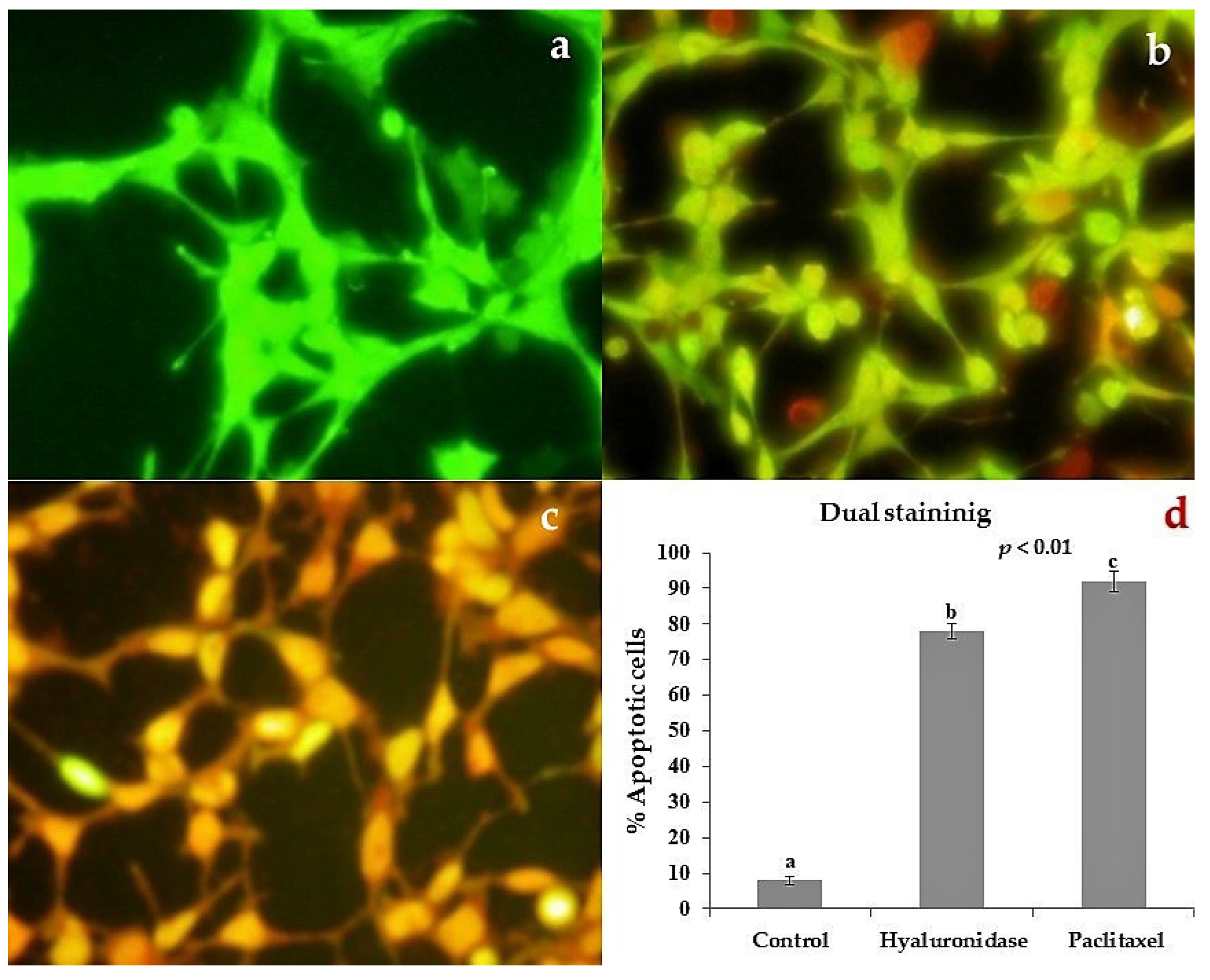
| Enzyme | Enzyme Solution Prepared (mU/mL) | Enzyme Solution to Add Incubated Samples (µL) | Enzymatic Activity in Incubated Samples (mU) | pH | Incubation Time (h) |
|---|---|---|---|---|---|
| Staphylococcal hyaluronidase | 20 | 10 | 0.22 | 5 | 0.3 |
| Streptomyces hyaluronidase | 20 | 10 | 0.21 | 5 | 0.3 |
| Bovine testicular hyaluronidase | 9.0 | 30 | 0.27 | 5 | 0.5 |
| NH42 (SO4) Saturation (%) | Protein Content (mg) | Total Activity (U/mL) | Specific Activity (U/mL/Protein) | Recovered Protein Activity (%) | Recovered Protein Activity (%) | Purification Fold |
|---|---|---|---|---|---|---|
| CF | 254 | 593 | 2.33 | 100 | 100 | 1 |
| 0–10 | 56.2 | 18.76 | 0.36 | 22.66 | 4 | 0.14 |
| 10–20 | 49 | 11.22 | 0.24 | 19.18 | 2.01 | 0.12 |
| 20–30 | 36 | 34.26 | 0.85 | 14.66 | 6.02 | 0.6 |
| 30–40 | 28.1 | 14.14 | 0.62 | 11.22 | 3.01 | 0.26 |
| 40–50 | 23 | 14.74 | 0.78 | 9.46 | 3.04 | 0.32 |
| 50–60 | 19.2 | 11.36 | 0.64 | 7.2 | 2.01 | 0.29 |
| 60–70 | 19 | 12.18 | 0.69 | 7.16 | 2.05 | 0.3 |
| 70–80 | 13.14 | 48.62 | 4.12 | 4.82 | 9.12 | 1.82 |
| 80–90 | 10.12 | 198.12 | 19.26 | 4.12 | 33.26 | 9.12 |
| Total | 253.76 | 363.40 | 27.56 | 93.32 | 64.52 |
Disclaimer/Publisher’s Note: The statements, opinions and data contained in all publications are solely those of the individual author(s) and contributor(s) and not of MDPI and/or the editor(s). MDPI and/or the editor(s) disclaim responsibility for any injury to people or property resulting from any ideas, methods, instructions or products referred to in the content. |
© 2023 by the authors. Licensee MDPI, Basel, Switzerland. This article is an open access article distributed under the terms and conditions of the Creative Commons Attribution (CC BY) license (https://creativecommons.org/licenses/by/4.0/).
Share and Cite
Thirumurthy, K.; Kaliyamoorthy, K.; Kandasamy, K.; Ponnuvel, M.; Viyakarn, V.; Chavanich, S.; Dufossé, L. Antioxidant and Anti-Breast Cancer Properties of Hyaluronidase from Marine Staphylococcus aureus (CASMTK1). J. Mar. Sci. Eng. 2023, 11, 778. https://doi.org/10.3390/jmse11040778
Thirumurthy K, Kaliyamoorthy K, Kandasamy K, Ponnuvel M, Viyakarn V, Chavanich S, Dufossé L. Antioxidant and Anti-Breast Cancer Properties of Hyaluronidase from Marine Staphylococcus aureus (CASMTK1). Journal of Marine Science and Engineering. 2023; 11(4):778. https://doi.org/10.3390/jmse11040778
Chicago/Turabian StyleThirumurthy, Kathiravan, Kalidasan Kaliyamoorthy, Kathiresan Kandasamy, Mohanchander Ponnuvel, Voranop Viyakarn, Suchana Chavanich, and Laurent Dufossé. 2023. "Antioxidant and Anti-Breast Cancer Properties of Hyaluronidase from Marine Staphylococcus aureus (CASMTK1)" Journal of Marine Science and Engineering 11, no. 4: 778. https://doi.org/10.3390/jmse11040778
APA StyleThirumurthy, K., Kaliyamoorthy, K., Kandasamy, K., Ponnuvel, M., Viyakarn, V., Chavanich, S., & Dufossé, L. (2023). Antioxidant and Anti-Breast Cancer Properties of Hyaluronidase from Marine Staphylococcus aureus (CASMTK1). Journal of Marine Science and Engineering, 11(4), 778. https://doi.org/10.3390/jmse11040778








